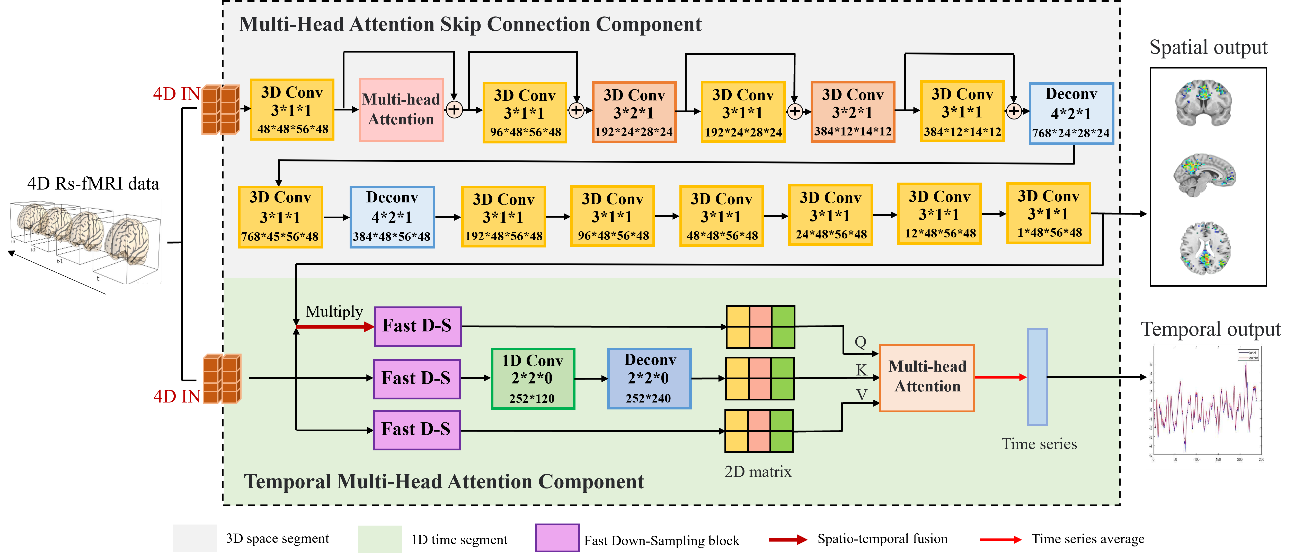近日,研究中心硕士生袁航的一篇论文“Modeling Default Mode Network Patterns via a Universal Spatio-Temporal Brain Attention Skip Network”被NeuroImage(JCR一区,影响因子5.7)录用。(论文链接地址:https://doi.org/10.1016/j.neuroimage.2024.120522)

论文摘要: 设计一种基于静息态功能磁共振成像(Rs-fMRI)的整体4D默认模式网络(DMN)建模方法来揭示个体DMN的时空模式,对于理解大脑的认知机制和精神疾病的发病机制至关重要。然而,现有的DMN建模方法仍存在两个局限性。这些方法要么(1)简单地拆分Rs-fMRI时空成分,忽略了时空模式的整体特征;要么(2)在DMN建模的特征提取过程中存在偏差,导致其时空精度无法保证。为此,本文提出了一种新的时空脑注意力跳跃网络(STBAS-Net)来模拟DMN的个性化时空模式。STBAS-Net由空间和时间两部分组成,其中空间部分的多头注意力跳连接模块在浅层阶段实现了细节特征提取和增强。在空间信息的指导下,我们对时间分量中的多种时空信息进行了技术性融合,巧妙地利用整体时空特征,实现了时空模式的相互制约,从而表征出DMN的时空模式。我们在公开发布的 4D Rs-fMRI 数据集和早期轻度认知障碍(EMCI)数据集上验证了所提出的STBAS-Net。实验结果表明,与现有的先进方法相比,所提出的网络能更准确地模拟人脑DMN的个性化时空模式,并能成功识别EMCI患者的异常时空模式。这项研究为揭示人脑DMN的时空模式提供了一种潜在的工具,有望为未来探索大脑异常时空模式和其他脑功能网络建模提供有效的方法框架。
Abstract: Designing a comprehensive four-dimensional resting-state functional magnetic resonance imaging (4D Rs-fMRI) based default mode network (DMN) modeling methodology to reveal the spatio-temporal patterns of individual DMN, is crucial for understanding the cognitive mechanisms of the brain and the pathogenesis of psychiatric disorders. However, there are still two limitations of existing approaches for DMN modeling. The approaches either (1) simply split the spatio-temporal components and ignore the overall character of the spatio-temporal patterns or (2) are biased in the process of feature extraction for DMN modeling, and their spatio-temporal accuracy is thus not warranted. To this end, we propose a novel Spatio-Temporal Brain Attention Skip Network (STBAS-Net) to model the personalized spatio-temporal patterns of the DMN. STBAS-Net consists of spatial and temporal components, where the multi-head attention skip connection block in the spatial component achieves detailed feature extraction and enhancement in the shallow stage. Under the guidance of spatial information, we technically fuse multiple spatio-temporal information in the temporal component, which dexterously exploits the overall spatio-temporal features and achieves mutual constraints of spatio-temporal patterns to characterize the spatio-temporal patterns of the DMN. We verify the proposed STBAS-Net on a publicly released 4D Rs-fMRI dataset and an EMCI dataset. The experimental results show that compared with existing advanced methods, the proposed network can more accurately model the personalized spatio-temporal patterns of the human brain DMN and successfully identify abnormal spatio-temporal patterns in EMCI patients. This study provides a potential tool for revealing the spatio-temporal patterns of the human brain DMN and is expected to provide an effective methodological framework for future exploration of abnormal brain spatio-temporal patterns and modeling of other functional brain networks.